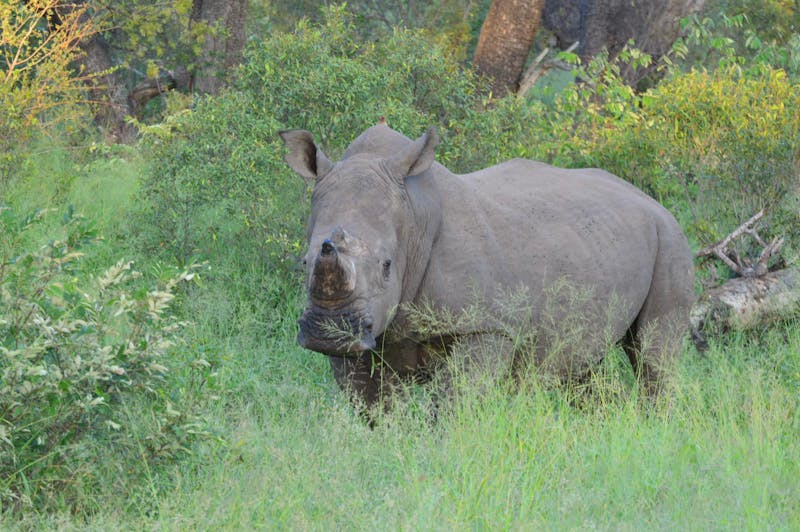
African black rhino: some eye-opening facts (Infographic)
What comes to mind when you think of a rhino? A large, bad-tempered prehistoric-looking creature? To some point that might be true, especially considering rhinos have wandered the earth for over 50 million years, yet the rhinos we see today are vastly different to those prehistoric beasts. They have evolved, lived for some time, faded into extinction, and recently been the target of human greed and a commercial demand for poaching.
In our latest infographic, we provide some eye-opening facts about the African black rhino and explain how you can get involved and make a difference in its status.

Read the stats from the African black rhino infographic below!
One of the charismatic 'big 5', the black rhino is smaller than its white rhino counterpart, but can still weigh in at a pretty hefty 1.4 tonnes.
Known as the shyer of the two species, the black rhino can be a solitary animal, although depending on the habitat, they have been known to congregate socially at waterholes. Despite its name, the black rhino is a dark grey in appearance. They have a primary distinguishing feature of a prehensile, or hooked, lip that It uses to feed on a variety of plants.
Black rhino fact file
Status: Critically Endangered
Population: Fewer than 5,000
Scientific name: Diceros bicornis
Size (Adult): 1.3m - 1.8m tall (at the shoulder) and 2.8m - 3.8m long (without tail)
Weight (Adult): 800 -1400kg
Max speed: 55km/h
Habitat: Tropical and Subtropical grasslands, savannas, deserts and xeric shrublands
Typical territorial area: Males up to 4.7km² and females up to 7.7km²
Where can the black rhino be found?
- Botswana
- Kenya
- Malawi
- Mozambique
- Namibia
- South Africa
- Swaziland
- Tanzania
- Zambia
- Zimbabwe
Did you know?
- Black rhinos have poor eyesight and find it difficult to detect objects more than 30 metres away. Despite this, they do have an excellent sense of smell and hearing. So make sure you have a bath and stand very still!
- Black rhinos live between 30 and 35 years in the wild but can live up to 45 years in captivity.
- Black rhinos have three toes and a soft wrinkled sole. The front feet are larger than the back.
- If you're looking to get on the good side of a black rhino, then point them in the direction of trees and bushes. Acacia is a particular favourite.
- A black rhino's front horn is the longer of the two horns averaging 50cm in length.
- Colonial age hunting was previously the major factor in the decline of the black rhino population.
- Poaching for illegal horn trade by organised criminal gangs is now a major threat to the black rhino population.
- Powdered rhino horn is used in traditional Asian medicines, and is often seen as a symbol of wealth.
Volunteer with rhinos at African Conservation Experience
Learn more about rhino conservation in their natural habitat with an unforgettable on-the-ground experience at African Conservation Experience.
Travel through Kruger National Park to protect wild rhino populations, rehabilitate orphaned baby rhinos, and much more, ACE's rhino conservation projects are a once-in-a-lifetime adventure that makes a difference.
The Vikela Kruger Conservation Experience
Become a rhino ambassador and get involved with one of the most urgent conservation challenges in Africa.
The Vikela Kruger project covers everything from learning about the poaching crisis to providing protection through field tracking and monitoring, observing rhino behaviour and helping with the data collection of other wildlife in the Kruger.
This is an incredible opportunity to gain invaluable local knowledge from conservation specialists while exploring the vast and beautiful African wilderness. It's a unique way to immerse yourself in on-the-ground rhino conservation, based in an area of abundant species diversity. Don't miss out on this once-in-a-lifetime chance!

Golola Rhino Orphanage and Rehabilitation Centre
Golola Rhino Orphanage and Rehabilitation Centre is the world's oldest rhino orphanage where you can gain hands-on experience in caring for orphaned or injured baby rhinos. You'll also get the opportunity to monitor rhinos released in a wildlife reserve within a UNESCO-protected site.
With the guidance of a knowledgeable team of zoologists, conservationists, and researchers, you'll be actively involved in every aspect of rhino rehabilitation.
In the morning, you may find yourself bottle-feeding a recently orphaned baby rhino as it begins its journey towards rehabilitation. In the afternoon, you might be surrounded by wildebeest and zebra, while monitoring rhinos that have been successfully released back into the wild. And by night, you could be preparing a meal with your fellow volunteers, while discussing the day's activities.

Care for Wild Africa Rhino Sanctuary
Want to help an orphaned baby rhino? Interested in nursing African wildlife, hand-rearing and rehabilitating rhinos?
Care for Wild Africa Rhino Sanctuary is a wildlife rehabilitation centre, specialising in infant wildlife care. The centre provides care for around 20 black and white rhino calves, and a host of other animals such as hippos, vervet monkeys, birds of prey and more.
Care For Wild Africa Rhino Sanctuary is a world-renowned wildlife conservation project that spans over 7,500 acres (3,000ha) of wildlife reserve. It is one of the largest and most successful rhino sanctuaries globally. You can experience living and working inside this sanctuary and be a part of this remarkable conservation project.


